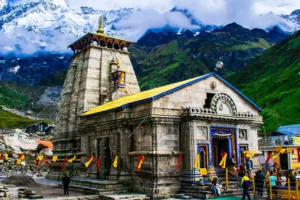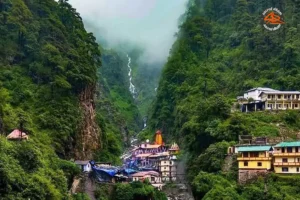Badrinath Temple
The grand entrance of the Badrinath temple, famously known as Singhdwar, is vibrant and majestic. Rising about 50 feet, the shrine has a small golden cupola at the top. The structure is divided into three main sections: (a) the Garbha Griha or sanctum sanctorum, (b) the Darshan Mandap where daily rituals take place, and (c) the Sabha Mandap, a spacious hall for devotees to gather.
Just opposite the main deity inside the Mandir Gate sits the idol of Garud, the celestial vehicle of Lord Badarinarayan. Depicted in a kneeling posture with folded hands, Garud faces the Lord in eternal devotion. The mandapa’s walls and pillars are adorned with intricate carvings that reflect fine craftsmanship.
The Garbha Griha has its canopy plated with gold. Here rests Lord Badari Narayan alongside idols of Kuber (the god of wealth), Narad Rishi, Uddhava, Nar, and Narayan. Altogether, the complex houses 15 idols. The most striking among them is the one-meter tall image of Lord Badrinath, carved from black stone. As legends tell, Adi Shankaracharya discovered this idol of Lord Badarinarayan, made of Saligram stone, in the Alaknanda River. Initially placed in a cave near Tapt Kund, the idol was later shifted to the present temple in the 16th century by the King of Garhwal. Lord Vishnu here is depicted in Padmasan, a meditative pose.
Darshan Mandap
In the Darshan Mandap, Lord Badari Narayan is shown with four arms—two holding the Conch and Chakra in raised positions, and two resting in a yogic posture. He is seated beneath the Badari tree, surrounded by Kuber, Garuda, Narad, Nar, and Narayan. On his right side stands Uddhava, while Nar and Narayan are placed further right. Narada Muni, though kneeling in devotion, remains slightly hidden from view. To the left, one finds Kubera, the silver idol of Lord Ganesha, and Garuda bowing in prayer.
Sabha Mandap
The Sabha Mandap is the assembly area of the temple, where pilgrims gather before and after darshan.
History of Badrinath Temple
The name Badrinath comes from Badari, a type of wild berry found in the region. According to tradition, when Lord Vishnu meditated in these mountains, Goddess Lakshmi took the form of a berry tree and sheltered him from the harsh weather. Over centuries, this place became a seat of divine energy, attracting sages, saints, and countless devotees.
“According to Skand Puran, the idol of Lord Badarinath was recovered by Adiguru Shankaracharya from Narad Kund and was re-enshrined in the 8th century A.D. in this temple.”
Tradition says Badrinath, also called Badari Vishal, was revived by Adi Shankaracharya to restore Hinduism’s spiritual prominence during a period when Buddhism was gaining strong influence in the Himalayas. He aimed to unite the nation through devotion and established major shrines dedicated to Lord Shiva and Lord Vishnu, with Badrinath being one of the most revered.
This temple has deep connections with ancient legends. The Mahabharata mentions the Pandavas and Draupadi crossing Badrinath on their last journey towards Swargarohini—their ascent to heaven. Lord Krishna, Narada, and many other sages are also said to have visited this holy site.
The Skanda Purana states: “There are several sacred shrines in heaven, on earth, and in hell; but there is no shrine like Badarinath.” Similarly, the Vamana Purana records that sages Nara and Narayana, considered an incarnation of Lord Vishnu, performed penance here.
Great saints like Kapila, Gautam, and Kashyap meditated in this land. Narada is believed to have attained salvation here, while scholars such as Adi Shankaracharya, Ramanujacharya, Madhavacharya, and Nityananda also spent time in Badrinath, seeking divine wisdom.
What to Know About Badrinath
Badrinath, also called the Badrinarayan Temple, lies in Uttarakhand’s Badrinath town. It is one of the four sacred Char Dhams, along with Yamunotri, Gangotri, and Kedarnath. Every year, thousands of devotees flock to these shrines, making them central to spiritual tourism in North India.
The temple sits at an altitude of around 3,100 meters in the Garhwal Himalayas, along the Alaknanda River, between the Nar and Narayana mountain ranges. Established in the 8th century by Adi Shankaracharya, it remains dedicated to Lord Vishnu. The temple is open for six months each year, while heavy snowfall in winter renders it inaccessible.
What To Do
Village Tourism
A visit to Mana, India’s last village near the border, is a must. With its stone houses and locals from the Bhotiya tribe engaged in weaving, Mana offers both charm and culture. A short trek from Badrinath to the village lets travelers experience the beauty of Himalayan life.
Ashram Tourism
Badrinath is also home to several ashrams that provide peaceful stays for visitors. Places like Parmarth Lok Ashram, Manav Kalyan Ashram, and Bholagiri Ashram welcome devotees for meditation, yoga, or simply quiet reflection amidst natural beauty.
Attractions
- Vyas Gufa: Vyas Gufa lies about 4 km from Badrinath. Here, sage Ved Vyas dictated the Mahabharata, and Lord Ganesha wrote it down. As the story goes, the roar of River Saraswati disturbed the writing. When the goddess ignored Ganesha’s request to lower the noise, he cursed the river to disappear underground. The river flows beneath the surface here and later resurfaces at Prayag. The cave’s roof looks like pages of an ancient scripture, making it unique.
- Mana Village: Mana sits on the banks of River Saraswati at an altitude of nearly 3,000 meters. It is the last Indian village near the international border. Surrounded by Himalayan peaks, the stone houses and narrow lanes make it look like a scene from a fairytale. Located just 4 km from Badrinath, Mana also serves as a base for many trekking routes.
- Hemkunt Sahib: Devotees believe Guru Gobind Singh Ji, the tenth Sikh Guru, meditated here for ten years. The gurudwara rests among snow-clad Garhwal peaks, surrounded by Hemkund Parvat. Every year, thousands of pilgrims visit, and many also volunteer to repair the trail damaged by winter snow.
- Satopanth Tal: Satopanth Tal, a triangular glacial lake, lies 25 km from Badrinath. Peaks like Chaukhamba, Neelkantha, Swargarohini, and Balakun surround the lake. Locals say Brahma, Vishnu, and Shiva meditated here. The Mahabharata also mentions this site. The trek to the lake passes through Mana village, Vasudhara Falls, and Sahastradhara Falls, offering a mix of spirituality and adventure.
- Vasudhara Falls: Vasudhara Falls lies 10 km from Badrinath. The waterfall plunges from a height of about 122 meters over a bare rock face. The trek to the falls offers breathtaking views and makes it a favorite spot for nature lovers.
- Hot Springs: Badrinath is also famous for its hot water springs. The main ones are Tapt Kund, Narada Kund, and Surya Kund. Narada Kund is known as the place where sage Narada wrote the Bhakti Sutra. Pilgrims believe the idol of Lord Vishnu was also found here. Devotees take a dip in these warm waters before entering the temple.
How to Reach
- By Flight: JThe nearest airport to Badrinath is Jolly Grant Airport, located about 35 km from Dehradun and 314 km from the temple. The airport has regular flights from Delhi. From Jolly Grant, taxis and buses are available, and the route to Badrinath is well connected by motorable roads.
- By Train: Rishikesh railway station is the closest railhead, around 295 km before Badrinath on NH58. It has frequent train services connecting major cities of India. From Rishikesh, buses and taxis operate regularly towards Badrinath via Srinagar, Rudraprayag, Chamoli, Joshimath, and other towns.
- By Road: Badrinath is easily accessible through motorable roads from different parts of Uttarakhand. Regular buses run from ISBT Kashmiri Gate in New Delhi to Haridwar, Rishikesh, and Srinagar. From these towns, visitors can hire taxis or board buses for Badrinath. The shrine also connects to Ghaziabad through National Highway 58, ensuring a smooth journey for pilgrims.
Best Time to Visit Badrinath
The best season to visit Badrinath Temple is between May and October. The shrine remains closed during late October or November and reopens in April every year.
Winter (October to April)
Winters in Badrinath are extremely cold. Temperatures often drop below freezing, and heavy snowfall is common. Due to harsh weather, this is not considered a suitable time for travel.
Summer (May to June)
Summer brings pleasant weather with a mildly cold climate. These months are perfect for sightseeing, outdoor activities, and the sacred pilgrimage to Badrinath.
Monsoon (July to mid-September)
The monsoon season sees frequent rainfall, and the temperature dips further. Roads may get slippery, so it is advisable to check the route condition from Rishikesh to Badrinath before starting the journey.
The sacred town of Badrinath usually stays open for visitors from April/May to November. While summers are cool and comfortable, winters remain freezing with regular snowfall.
Accommodation Facilities at Badrinath Dham
Pilgrims visiting Shri Badrinath have several accommodation options, both near the temple and in nearby towns.
- BKTC Guest Houses at Shri Badrinath provide simple yet comfortable lodging.
- Other Guest Houses are also available in the temple town.
- Dharamshalas managed by different organizations offer budget stays at nominal charges.
- Private Hotels cater to visitors looking for more facilities.
- Joshimath Accommodation (about 45 km from Badrinath) offers many choices including guest houses, hotels, and dharamshalas.
Since Badrinath is located at a high altitude, many pilgrims prefer to stay in Joshimath and complete their darshan of Badrinath in a single-day trip.
Conclusion
If you are longing for peace of mind and a soulful retreat, Badrinath Temple is the perfect place to visit. Step into the sacred temple complex and fulfill your spiritual journey with divine blessings. Let the atmosphere of Badrinath surround you with serenity and devotion, offering an experience unlike any other.





